California
Estate
The Cauldwell Hall Estate
Cauldwell Hall – the name can be found on our Street name derivations page – as a farm,
is said to date back to Anglo-Saxon times. After the
Norman Conquest in 1066, lands were seized by King William I and gifted
to the new Norman establishment, in this case to Roger Bigod***, the
High
Sheriff of Norfolk and Suffolk. The name 'Cauldwell' or its variants,
as a Manor, may date from the early 14th century in the ownership of
the Holbroke family. John de Holbroke, son of Richard de Holbroke, held
the manor in about 1300, but died in 1376 and the estate passed the
same way as the Manor of Holbrook. However, Edmunde de Caldeswelle
appears to have been in residence in the Holbrook manor house in 1327;
successive generations of Caldwells became well respected citizens in
civic and religious matters. The first record of a Caldwell living at
Caldwell Hall was in the 15th century, but it is likely that the family
had been living there for many generations prior to this, even though
it was owned by the Holbroke family.
[*** Roger Bigod (died 1107) was a Norman knight who travelled to
England in the Norman Conquest. He held great power in East Anglia; the
Domesday Book lists Roger as holding six lordships in Essex, 117 in
Suffolk and 187 in Norfolk. Five of his descendants were Earls of
Norfolk. He was also known as Roger Bigot. Incidentally, Bigod's Quay
on Ipswich docks was near StokeBridge and it lay on the site of
Cranfield’s Mill (today's 'The Mill'). It
was his son, Hugh Bigod, who built the castle in Ipswich that was
besieged in 1153. After the death of the last Bigod in 1306 the quay
passed to the Brothertons and then the Mowbray family until 1491.
Thereafter it belonged to various important Ipswich families: James
Hobert, John Nicholls, and the Barker family.]
From a contemporary record from a time in the history of the town when
the Craftsmen's Guilds flourished, there is a reference which reads:
'In 1444, John de Caldwell, in residence at Caldwell Hall, is to pray
for the good state of the merchant's Guild'. In the Accounts of the
Corpus Christie Guilds & Pageants in the 23rd year of Henry VI
(1445) mention is made of John de Caldwell who played a prominent role
in the procession and was again described as a member of the family
resident at Caldwell Hall. In the 16th century when Caldwell Hall
was still part of the extensive property of the Christchurch Priory,
the assets of the Priory were seized by Cardinal Wolsey to provide
funds for his ill-fated College which
he started to build in Ipswich in the late 1520s. With his fall from
grace and subsequent death, the Priory with its lands passed into the
hands of Sir John Pope and then the Withepole family, who built Christchurch Mansion in 1563. It stayed
this way for many generations. By the early part of the 17th century,
the Caldwell Hall estate had passed to Robert Leman.
At his death in 1637, Leman left to his daughters Caldwell Hall
and, amongst other properties, a sizeable mansion in Upper Brook Street
and £10 to the Ipswich Public Library, a frerunner of the current
library. In 1775 William Rivers took out a loan of £3000 from Tobias
Rustat, Rector of Stutton to buy the 550 acre Cauldwell Hall estate
using the estate itself as security. Sometime prior to this, the estate
had been in the occupation or tenure of John Wilkinson, then Robert
Wilkinson at a yearly rent of £100. By the time it was surveyed by
Samuel Lewis for William Rivers in 1793, the estate was just over 403
acres in size. The vast majority of it (369 acres), was within the
parish of St Margaret, with 14
acres each in the parishes of both Rushmere and St Helen. An additional
three acres were taken up by roads on the estate. The estate stretched
from
the Foxhall Road in the south to Sidegate Lane, where today it meets
the Colchester Road in the north. To the west the boundary is roughly
in line with today's Spring Road viaduct and in the east where the
Woodbridge Road meets Spring Road at the Lattice Barn public house.
By 1809, the Rivers family decided to sell land off to pay off the
interest on the mortgage bringing down the size of estate to around 400
acres. Although the interest had been paid off, the original £3000
mortgage still remained outstanding. In 1822, with John Rivers not in
good health, it is not surprising that they were looking to liquidate
their assets. The Cauldwell Hall estate had been farmed by the Rivers
family for three generations but clearly John Rivers, grandson of
William Rivers, could no longer cope with the demands of the 400 acre
estate.
Estate sale and the F.L.S.
In 1848 the whole estate was bought by John Footman who was a
proprietor of the well established Ipswich linen and woollen drapery
business, John Footman & Co, later to become Footman, Pretty and
Nicholson. John Footman quickly sold on large areas of the property and
it is likely that he was acting on behalf of a number of others;
perhaps they had agreed not to bid against each other to ensure a
bargain price. It is not known who bought the Cauldwell Hall Farmhouse,
nor who did the extensive makeover in an Italianate style, including a
signoral tower.
From 1919 to his death in 1956 Cauldwell Hall was the home of the
Ipswich solicitor Lionel H Vulliamy. When Lionel Vulliamy purchased
Cauldwell Hall he was a partner in the family firm of Vulliamy and Son.
By 1922 the firm had merged with Steward and Rouse becoming Steward,
Vulliamy and Aldous, who were based in Arcade Street, Ipswich. During
his ownership of Cauldwell Hall, Lionel Vulliamy landscaped the lower
gardens including the old pond and introduced flamingos to the grounds.
Photographs from the Vulliamy family album show how this work
progressed. They also give a good view of the overall extent of the
house and grounds in the 1940s and 1950s. After Lionel H. Vulliamy
died,
the property was sold to L. D. Bloom Estates who divided Cauldwell Hall
into apartments and built Trafalgar Close in the lower grounds. The
gatehouse and trees fronting on to Spring Road were taken down in 1956.
Today, looking up from Spring Road, Cauldwell Hall can be glimpsed
through the trees, high above the road.
The development of the Cauldwell Hall Estate for housing started
in the
early days of the Ipswich & Suffolk Freehold
Land Society (F.L.S.) which was
formed in 1849: the year of the California gold rush – hence the
nickname of the area*. The extensive farmlands belonging to Cauldwell
Hall, which in its Victorianised version still stands off Cauldwell
Avenue overlooking Spring Road, came up for sale in 1848. The land was
sold off to various buyers. One of these was William Dilwyn Sims who
became Vice-President of the F.L.S. and acted as agent in the purchase
of ninety-eight and a half acres of the Estate on 18
October 1850. The Ipswich & Suffolk
Freehold Land Society could not legally purchase land in its own right,
so he made the land over
to
the F.L.S. some time during 1850. The price was £4,992: over £50
per
acre.
(*Some people believe that 'California' was used to reflect the
pioneer spirit of the settling smallholders on the estate; even that
the grid pattern of roads echoed that of the USA. Both of these are
questionable.)
The land between Woodbridge Road and Foxhall Road was divided up into
282 plots, each of which was offered to senior members of the F.L.S. at
£21.10 shillings each. Among expenses were £26 for staking out and
£480 for making roads, which were laid out in a grid pattern. New roads
named Cauldwell Hall Road and Britannia Road formed the western and
eastern boundaries respectively, with Freehold Road bisecting the area
from west to east between the two. Howard Street, Milton Street and
Kirby Street were laid out between Woodbridge Road and Spring Road.
Crabbe Street, Cowper Street and Bloomfield Street were laid out
between Spring Road and Freehold Road, also Parliament Road between
Freehold Road and Foxhall Road. The estate was divided by
Christopher Fleury (architect of the first Ipswich
Museum and Ipswich School on Henley Road), the Society’s Surveyor who
stated, when announcing the allocation of the allotments, that he was
’… aware in the division of so much property difficulties might arise
in giving satisfaction to so many allottees; ... Indeed, this was to
prove the case and it may be why from then on, a ballot was held to
allocate the plots for all subsequent land purchases by the Society.
[Much of the information above is drawn from Gooding, A: The history of Cowper Street, Ipswich.
See Reading list]
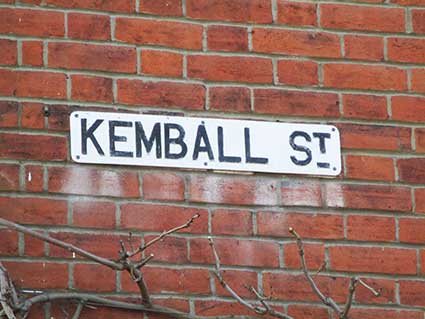 2021 image
2021 image
Kemball Street and Henslow Road drop down from Freehold Road
between Cauldwell Hall Road and Parliament Road. Two parallel,
east-west roads
were planned between Kemball and Henslow, but were never built. See our
Street name derivations for the sources
of these last two thoroughfares. See our Named buildings page for the three
named and dated terraces at the Foxhall Road end on Henslow Road
including Henslow Terrace.
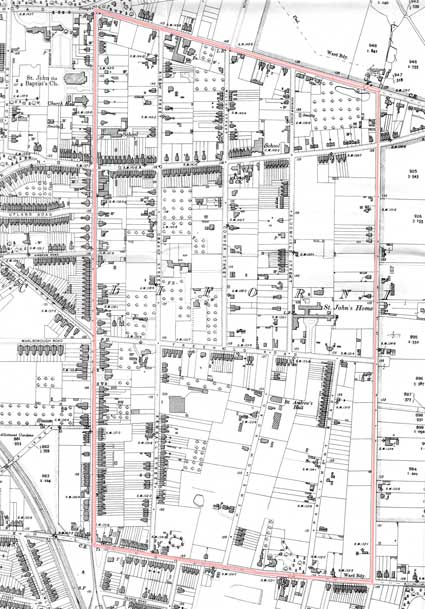
Above: the boundaries of the California estate marked in pink on
a 1902
map. Note the limited housing development at this time.
A brickyard existed to the east of Bloomfield Street, (see our Wherstead red brick page for more on this
and other brickyards) and the public house The Brickmakers Arms
survives near to the north of the street.
Sources of California street names
Apart from Kemball and Henslow (mentioned above), we
feel reasonably secure in allocating the street name sources to the
great and
good, mainly poets.
Poets Cottages. Interestingly
there are named 'Poets Cottages' in
Milton Street (itself within California).
And so to the naming of these streets
as follows:-
George Crabbe (1754-1832) was
born in Aldeburgh, Suffolk. He
was an English poet, surgeon, and clergyman. He is best known for his
early use of the realistic narrative form and his descriptions of
middle and working-class life and people.
John Milton (1608-1674) was an
English poet, polemicist, man of letters, and a civil servant for the
Commonwealth of England under Oliver Cromwell. He wrote at a time of
religious flux and political upheaval, and is best known for his epic
poem Paradise Lost (1667), written in blank verse.
John Kirby (1690-1753) was an
English land surveyor and topographer. His book The Suffolk Traveller,
first published in 1735, was the first single county road-book. Kirby
lived in Wickham Market, Suffolk and spent three years between 1732 and
1734 surveying the entire county. For part of this project he was
accompanied by Nathaniel Bacon. In 1736 he published a large-scale map
of Suffolk. Subscribers to this received a copy of his book as a free
gift. A further large scale map was published the following year. He
was the father of John Joshua Kirby (born in Wickham Market 1716-1774),
landscape painter, engraver, and writer, topographical
draughtsman and architect, famed for his
pamphlet on linear perspective based on Brook Taylor's mathematics.
Robert Bloomfield (1766-1823)
was born of a poor family in the village of Honington, Suffolk. He was an English labouring class poet
whose work is appreciated in the context of other self-educated writers
such as Stephen Duck, Mary Collier and John Clare. Howecer, Muriel
Clegg comes up with another derivation; see Street
name derivations.
William Cowper (1731-1800) was
an English poet and hymn writer. One of the most popular poets of his
time, Cowper (more correctly pronounced 'Cooper') changed the
direction of 18th century nature poetry by writing of everyday life and
scenes of the English countryside. He was born in Berkhampstead,
Hertfordshire and there doesn't
appear to be any link to Suffolk.
Henry Howard, Earl of Surrey,
KG (1517-1547) was an English aristocrat, and one of the founders of
English Renaissance poetry. He was a first cousin of Catherine Howard,
the fifth wife of King Henry VIII. He was the eldest son of Thomas
Howard, 3rd Duke of Norfolk.
Building
In 1850 building started straight away. By Census day, 30 March 1851,
some 27 houses had been erected: 21 of them occupied. They were
scattered over the estate and are difficult to locate exactly on the
Census returns. Roads had not then been named and the area was simply
known as The Cauldwell Hall Estate.
Until October 1850 there was a levy on building bricks, making
them expensive. Early houses were therefore built of flint rubble,
using bricks for the corners , window and door dressings and
chimneys. A few such houses remain including short terraces at 173-177
Cauldwell Hall Road (shown below) and nos. 9-13 Cowper Street.
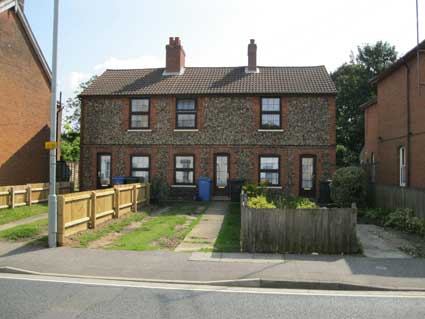
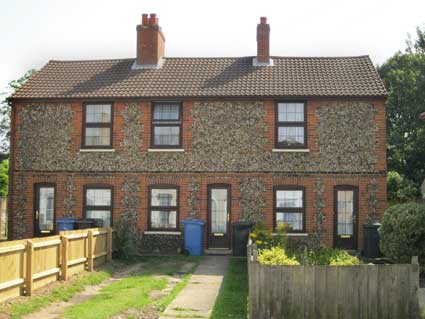
Set back from the building line of surrounding houses, these
cottages
use the cheapest unknapped flint construction materials with red brick
quoins and door and window detailing. Because of the 'cobble' shapes,
these flint walls require regular maintenence because without it they
can
weaken and collapse.
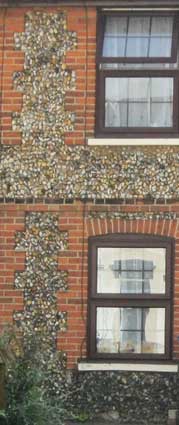 2014 images
2014 images
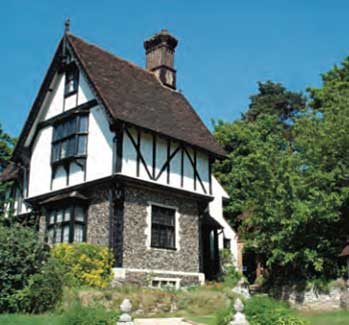 Gothic House
Gothic House
Kossuth Cottage, Gothic House
In Freehold Road on
the corner of Kemball Street is a larger, flint-built house – now a
pair –
originally called Kossuth Cottage.
Most other flint-built houses have been replaced by modern
buildings. The size of Kossuth Cottage is an indication
of both the 'non-standard' and piecemeal nature of building which took
place on the estate. Another example can be found in St Johns Road:
Gothic House, which is today number 5. The builder was Henry Ringham to
the design of an architect working for Phipson. Henry Ringham was a
noted wood-carver who did much restoration work in Suffolk churches. He
was self-taught in reading, writing, drawing and carving. As a builder
in 1861, he had forty men and two boys working for him. However, having
cash-flow problems, he was forced to sell Gothic House in 1863 to
Abednigo Chaplin, whose elder brother became great-grandfather to
legendary silent film star, Charles Chaplin. Despite falling on harder
times, Righam's wood-carving reputation earned him a place in history
when the nearby Chapel Lane was renamed Ringham Road.
Although the original intentions and principles upon which the
Ipswich & Suffolk Freehold Land Society were
based: to create
‘forty shilling freeholders’ – giving the ordinary man the chance to
buy enough land to entitle him to vote, inevitably businessmen and
speculators found ways of increasing their balotted allocations of land
and plots changed hands, sometimes from the outset. The 1879 F.L.S. map related to our
Rosehill case study page, although strictly speaking just outside the
original California area, indicates that the plot on which the branch
library was eventually built was sold early. It was not alone.
Much of the information on this page has been drawn from the
unpublished research of the California development by Hilary Platts, to
whom our thanks.
Ipswich Borough's 'Character Area'
Delving into the Ipswich Borough Council website, one finds a
clutch of colourful publications about 'character areas'. The
California one (the link is below) has lots of illustrations,
particularly a collection of details of garden railings, brickwork etc.
worthy of this very website... Two period views are well worth a look:
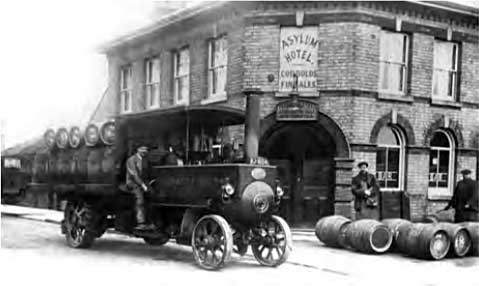
Above: The Asylum Hotel – names were brutally frank in them days – at
389 Foxhall Road, near to the Borough Asylum (later St Clement's
Hospital). This public house on the corner of Parliament and Freehold
Roads dates to the late 19th century and was renamed The Heathlands in
the 1920s. Today it is a supermarket. The blind window above the
attractive, arched corner entrance bears the words: 'ASYLUM HOTEL -
COBBOLDS FINE ALES', with an unreadable curved iron nameplate behind
the lamp.
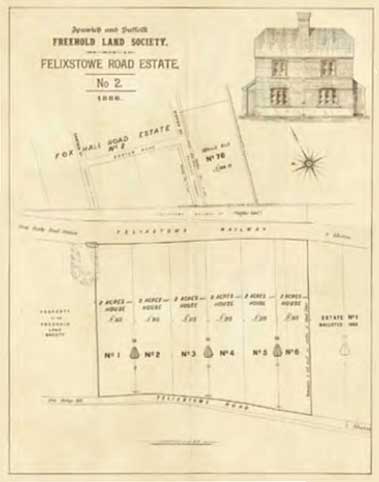
The Freehold Land Society illustration and map
above shows the 'Garden Farms' which were a feature of some FLS
developments. The houses were built within two acre plots facing
Foxhall Road and Felixstowe Road. The smallholding plots have since
been redeveloped, but a handful of the semi-detached houses survive
shown on our Felixstowe Roads FLS houses
page. Interestingly, the map of California as defined
in this Borough document is larger than the area originally established
by the FLS.
[The Borough's 'California Character Area' can be found at:
https://www.ipswich.gov.uk/sites/default/files/icd62_-_urban_charaacter_study_spd_california_area.pdf]
Related pages:
Kossuth Cottage in Freehold
Road, corner with Kemball Street.
House
name plaque examples: Alston Road;
Bramford Road;
Cauldwell Hall Road; Cavendish Street; Marlborough Road; Rosehill area;
Ipswich & Suffolk Freehold Land
Society (F.L.S.); Rosehill
case study;
Street index; Origins of street names
in Ipswich; Streets named after slavery
abolitionists.
Dated buildings list; Dated buildings examples;
Named
buildings list;
Named (& sometimes dated) buildings
examples.
Street nameplate examples; Brickyards
Home
Please email any comments and contributions by clicking here.
Search Ipswich
Historic Lettering
©2004 Copyright
throughout the Ipswich
Historic Lettering site: Borin Van Loon
No reproduction of text or images without express written permission
 2021 image
2021 image


 2014 images
2014 images
 Gothic House
Gothic House
